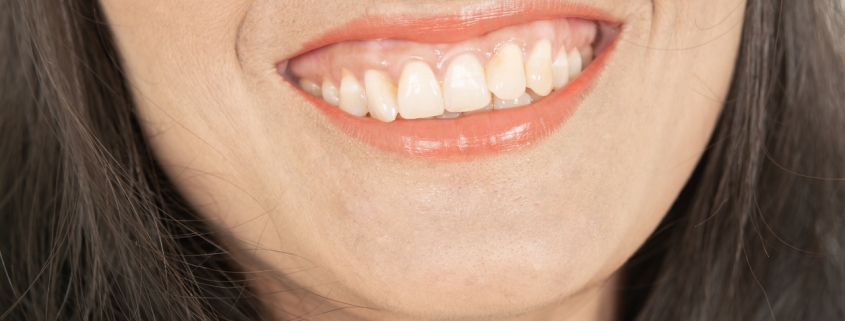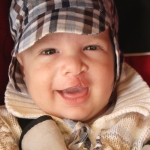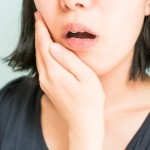What causes crooked and crowded teeth? Several different factors can cause the teeth to become crowded. Among its factors, we can mention the displacement and misalignment of the jaws, irregular size of the teeth, past dental injuries, small jaws, and cleft lip and palate.
Improper oral habits such as pressing the tongue against the front teeth when swallowing and speaking, finger sucking, mouth breathing, allergies, and asthma can lead to crooked and crowded teeth.
Types of overlapping teeth
In general, compaction of the teeth is caused by the mismatch between the space in the dental arch and the space required for the smoothness and alignment of the teeth. When there is not enough space to protrude all the teeth in the dental arch (depending on the moderate to severe heterogeneity), the teeth are tilted and compressed and overlap. Depending on the intensity, crowding and compaction of the teeth are classified into three groups:
First-degree or mild congestion
Secondary or moderate crowds
Third or severe congestion
Also, crowding of teeth can be divided into three categories: primary, secondary and tertiary crowding, which is actually the cause of this problem.
Early crowding of teeth: This condition, which is actually inherited, is passed on genetically from parents to children and is influenced by family history. In this type of misaligned teeth, the mismatch between the size of the teeth and the jaws is the main cause of lack of space. For example, you may inherit the small size of the father’s jaws and the size of the mother’s teeth.
Secondary crowding of teeth: This condition is acquired and is caused by the deflection of the posterior teeth forward, especially after the premature loss of deciduous teeth in the lateral part of the mouth, as well as the displacement of the front teeth backwards. Patients in this group are often advised to take care of their baby teeth and prevent them from decaying to avoid this problem. This problem can be prevented by controlling your diet, especially during mixed dentition and regular brushing.
Tertiary crowding of teeth: This situation is still under discussion. This type of crowding and crowding of teeth occurs primarily in the mandibular front teeth and begins during or after adolescence. It used to be thought that protruding wisdom teeth would cause this kind of crowding and crowding, but it is now clear that this can happen even if there is no wisdom teeth. The cause is attributed to the different front and back growths of the mandible and upper jaw, which end at different times. In addition, mandibular and maxillary rotation is different during growth. In today’s society, malocclusion due to lack of space and compression of the teeth is more common than the size of the jaw and the distance between the teeth.
What problems do crowded and crowded teeth cause?
This situation causes many problems. Perhaps the first problem is the ugliness of the smile and teeth. But the beauty of the teeth is not the only problem that is affected by the crookedness and compaction of the teeth. Other problems include excessive wear and tear on some tooth surfaces due to improper contact with adjacent teeth, gum infection due to difficulty cleaning the areas between the teeth, tooth decay, especially in areas of overlapping teeth, injury and joint pain Jaw and its consequences.
Note that clenching of the teeth is a common condition in childhood, and three out of four children have difficulty developing the jaw properly. Treating this condition at an advanced age is much better, simpler, more successful, less invasive and less expensive.
Methods of treating crowding and clenching of teeth
Treatment for this condition depends on the severity of the problem and may be corrected by simple action such as a stationary mouthpiece within a few months, or may require more complex and lengthy treatments, or even some teeth may need to be extracted. The treatment method depends on the severity of the lack of space, the patient’s age and his cooperation.
Remember that in order for the treatment results to be stable, the cause of the crooked and compressed teeth must be determined and resolved.
Treatment methods for crowded and crowded teeth are:
Fixed bracket: One or more permanent teeth may be extracted before flossing to provide enough space for the teeth to straighten and align. In the bracket or wiring method of teeth, small square jewels called bracket jewels are attached to the teeth and the orthodontic wire passes through each of them.
Transparent liner or Invisalign: Invisalign, also called invisible orthodontics or transparent brackets, is not actually attached to the teeth, unlike the bracket system, but is a transparent plastic mold that completely surrounds the teeth. It is used in such a way that the patient puts it in his mouth and whenever he wants to eat something or brush his teeth, he has to take it out.
Orthodontic retainer or retainer: This oral device is used to correct minor problems. Holly retainer is a plastic plate attached to the roof of the mouth that contains several metal hooks that hold it to the teeth and has a wire that is placed in front of the front teeth.
Why should we treat crooked and crowded teeth?
We need to make sure that the teeth and the supporting bone are in the right position to increase the durability and longevity of the teeth. Permanent teeth have no substitute, so you should do your best to make the most of them.



